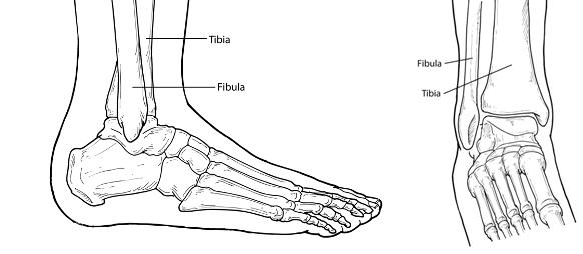Ankle Fracture
A broken ankle can involve one or more of the bones, as well as injury to the surrounding connecting tissues or ligaments. There are a wide variety of causes for broken ankles, most commonly a fall, an automobile accident, or sports-related trauma. Because a severe sprain can often mask the symptoms of a broken ankle, every ankle injury should be examined by a physician.

What Is an Ankle Fracture?
According to the American Academy of Orthopaedic Surgeons, doctors have noticed an increase in the number and severity of broken ankles since the 1970s, due, in part, to the Baby Boomer generation being active throughout every stage of their lives.
A fracture is a partial or complete break in a bone. Fractures in the ankle can range from the less serious avulsion injuries (small pieces of bone that have been pulled off) to severe shattering-type breaks of the tibia, fibula, or both.
Ankle fractures are common injuries that are most often caused by the ankle rolling inward or outward. Many people mistake an ankle fracture for an ankle sprain, but they are quite different and therefore require an accurate and early diagnosis. They sometimes occur simultaneously. A person may still be able to walk or put weight on their foot. If you put weight or walk on a fractured or broken ankle, it is possible to cause more damage or fracture the bone(s) further.
Symptoms
An ankle fracture is accompanied by one or all of these symptoms:
Pain at the site of the fracture, which in some cases can extend from the foot to the knee. No pain does not mean it isn’t a fracture.
Significant swelling, which may occur along the length of the leg or may be more localized.
Blisters may occur over the fracture site. These should be promptly treated by a foot and ankle surgeon.
Bruising that develops soon after the injury
Inability to walk—however, it is possible to walk with less severe breaks, so never rely on walking as a test of whether a bone has been fractured
Change in the appearance of the ankle – it will look different from the other ankle
Bone protruding through the skin—a sign of an emergency. Fractures that pierce the skin require immediate attention because they can lead to severe infection and prolonged recovery.
Diagnosis
Following an ankle injury it is important to have the ankle evaluated by a foot and ankle surgeon for proper diagnosis and treatment. If you are unable to do so right away, go to the emergency room and then follow up with a foot and ankle surgeon as soon as possible for a more thorough assessment.
The affected limb will be examined by the foot and ankle surgeon by touching specific areas to evaluate the injury. In addition, the surgeon may order x-rays and other imaging studies, as necessary.
Non-Surgical Treatment
Treatment of ankle fractures depends upon the type and severity of the injury. At first, the foot and ankle surgeon will want you to follow the R.I.C.E. protocol:
- Rest: Stay off the injured ankle. Walking may cause further injury.
- Ice: Apply an ice pack to the injured area, placing a thin towel between the ice and the skin. Use ice for 20 minutes and then wait at least 40
minutes before icing again. - Compression: An elastic wrap should be used to control swelling.
- Elevation: The ankle should be raised slightly above the level of your heart to reduce swelling.
Additional treatment:
The treatment for a broken ankle usually involves a leg cast or brace if the fracture is stable. If the ligaments are also torn, or if the fracture created a loose fragment of bone that could irritate the joint, surgery may be required to secure the bones in place so they will heal properly or repair soft tissue injuries, if present. The foot and ankle surgeon will select the procedure that is appropriate for your injury.
Follow-up Care
It is important to follow your surgeon’s instructions after treatment. Failure to do so can lead to infection, deformity, arthritis, and chronic pain.
